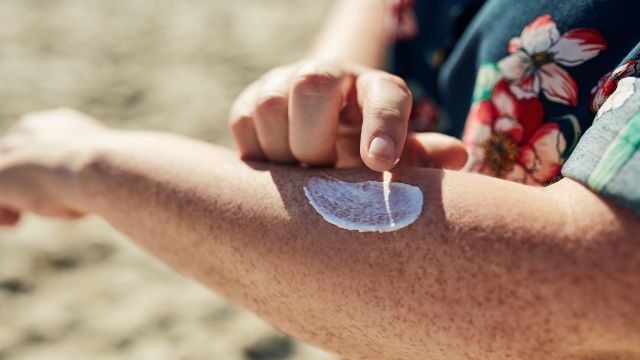Applying sunscreen when you go to the beach or the pool may seem like second nature, but according to the American Cancer Society, new cases of melanoma—the most serious form of skin cancer—have increased over the last 30 years, indicating that Americans may still not be slathering on enough sunscreen.
"You need to make applying sunscreen part of your daily routine," advises Gary Marder, a cosmetic dermatologist based in Port St. Lucie and Okeechobee, Florida. "Always wear a broad protection sunscreen with an SPF of at least 15 whenever you're going to be outside—driving, walking, biking, running, golfing, going to a park—especially if you live in a sunny area. It's especially important to cover areas that are often overlooked—your lips, nose, feet, hands, forearms, and any exposed areas of the scalp."
It might surprise you to know that skin cancer (not breast cancer or lung cancer) is the most common form of cancer in the United States. More than 3.5 million skin cancers are diagnosed annually, affecting more than two million people. According to the Skin Cancer Foundation, more than 90% of these new cases are caused by the sun's ultraviolet rays, or ultraviolet radiation (UVR). In addition, most of the skin problems we associate with aging—wrinkles, leathering, and discoloration, for example—are also UVR-related.
Types of Skin Cancer
Here are the three most common types of skin cancer:
- Basal cell carcinoma: The most frequently occurring type of skin cancer, basal cell carcinoma is an abnormal, uncontrolled growth in your skin's basal cells. Basal cell carcinomas often look like open sores, red patches, pink growths, shiny bumps, or scars. Usually caused by a combination of cumulative and intense, occasional UVR exposure, basal cell carcinoma growths almost never spread beyond the original skin site.
- Squamous cell carcinoma: Squamous cell carcinoma is an uncontrolled growth of abnormal cells in the squamous cells. Squamous cell carcinoma growths often look like scaly red patches, open sores, elevated growths with a central depression, or warts that may crust or bleed. It's mainly caused by UVR exposure over the course of a person's lifetime.
- Melanoma: Melanoma growths develop when ultraviolet rays from the sun or tanning beds trigger mutations in the skin cells, causing the cells to multiply rapidly and form malignant tumors. The majority of melanomas are black or brown, but they can also be skin-colored, pink, red, purple, blue, or white.
Risk Factors
Your skin type is a key factor in determining your risk for skin cancer. If you have fair skin, you have the highest risk, as you have less pigment to protect your skin from UVR exposure. If you have dark or olive skin, you have more pigmentation and therefore more natural protection. However, people with all skin types can get skin cancer. Other risk factors include having one or more severe sunburns as a child, an unusual number of moles, a family history of melanoma, and exposure to UVR, including rays emitted by tanning beds.
Prevention Tips
Follow these tips from The Skin Cancer Foundation to help protect yourself from skin cancer:
- Seek the shade. Avoid being in direct sun for more than a few minutes, especially between 10 a.m. and 4 p.m., when the sun's rays are strongest.
- Do not burn. A single sunburn increases your risk of developing melanoma, and having five or more sunburns doubles your lifetime risk of melanoma.
- Avoid tanning beds. Using a tanning bed or booth makes you 2.5 times more likely to develop squamous cell carcinoma and 1.5 times more likely to develop basal cell carcinoma. Even occasional sunbed use almost triples your chances of developing melanoma.
- Cover up. Protect your skin from the sun with clothing, including a broad-brimmed hat and UV-blocking sunglasses.
- Use a broad spectrum (UVA/UVB) sunscreen. Use an SPF of 15 or higher every day.
- Don't skimp on sunscreen. Apply 1 ounce (2 tablespoons) of sunscreen to your entire body 30 minutes before going outside. Reapply every 2 hours or immediately after swimming or sweating.
- Examine your skin. Check your skin from head to toe every month and have a professional skin exam every year. See your dermatologist or primary care physician if you have or develop a spot, sore, skin growth, mole, beauty mark, or brown spot that does one or more of the following:
- Continues to itch, hurt, crust, scab, erode or bleed
- Does not heal within two weeks
- Changes color or appears pearly, translucent, tan, brown, black or multicolored
- Changes in texture
- Increases in size or thickness
- Is asymmetrical
- Is irregular in outline or border
- Is bigger than 6mm, the size of a pencil eraser





